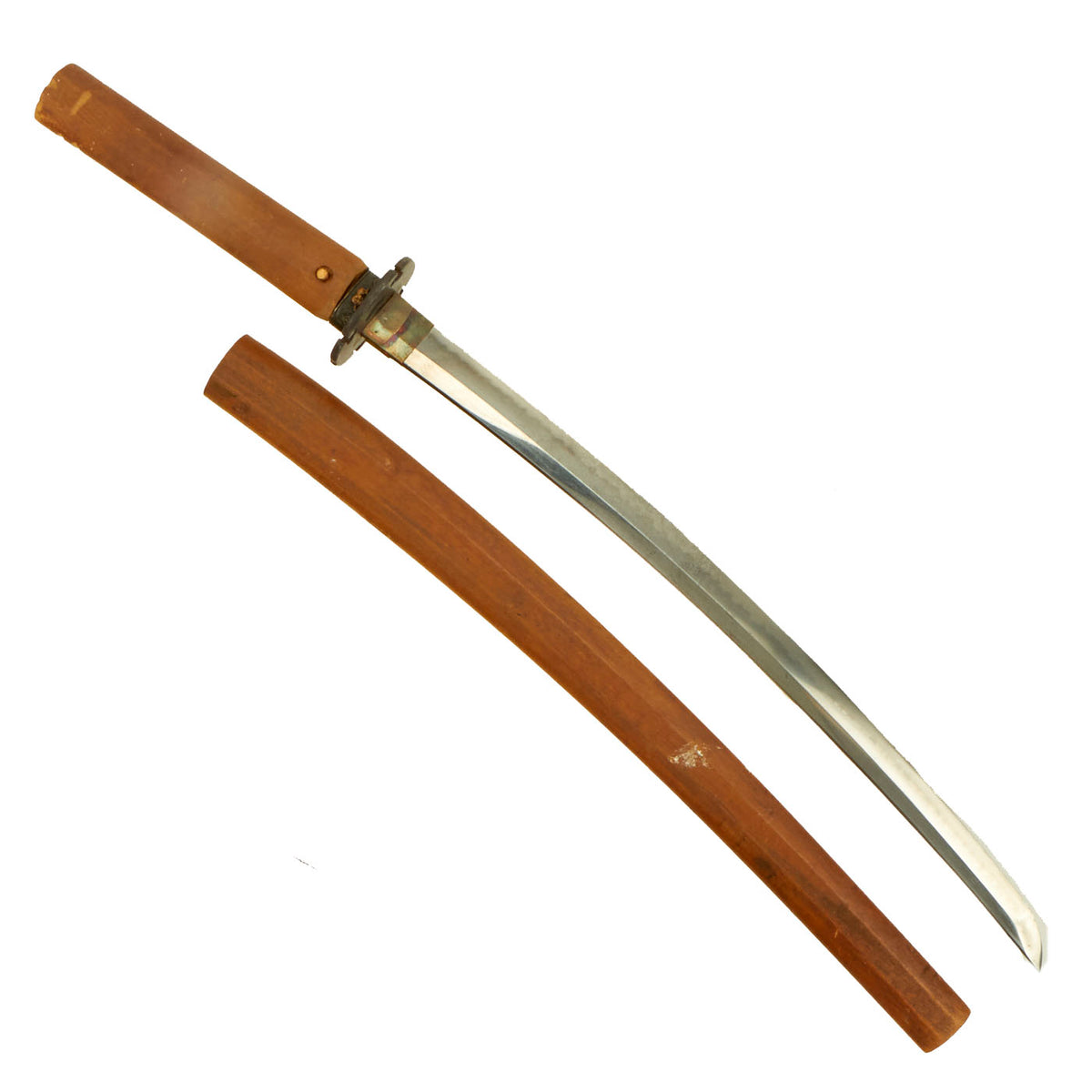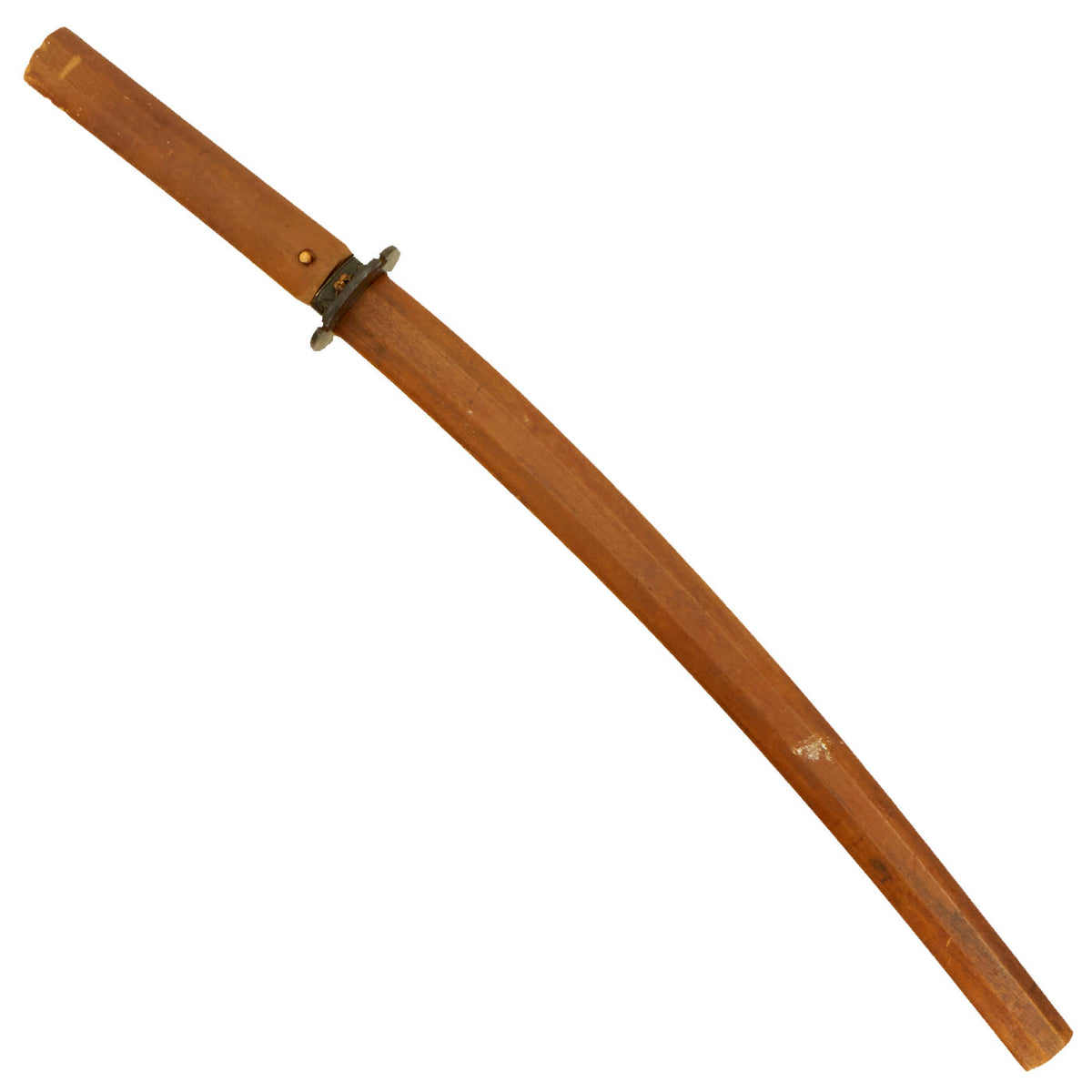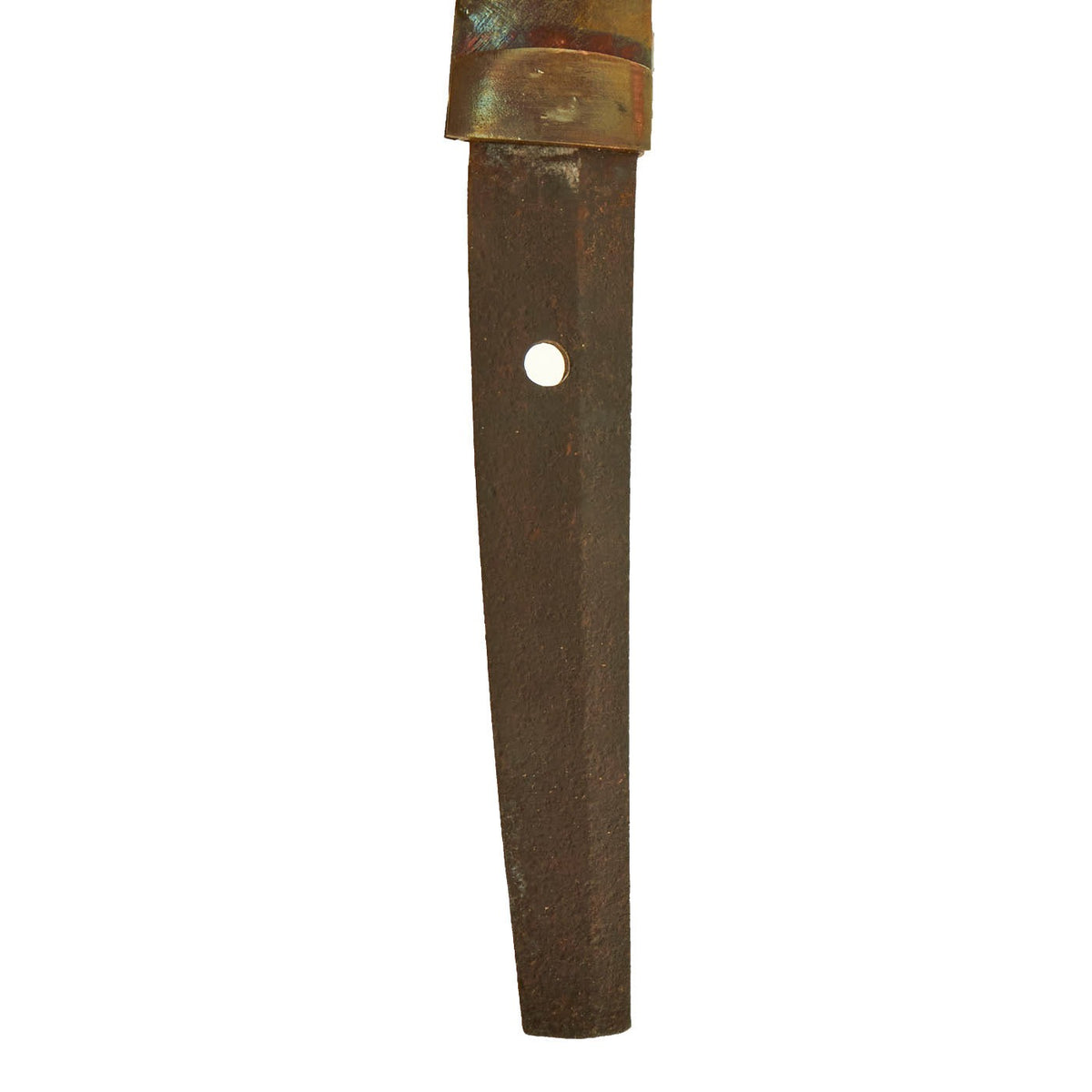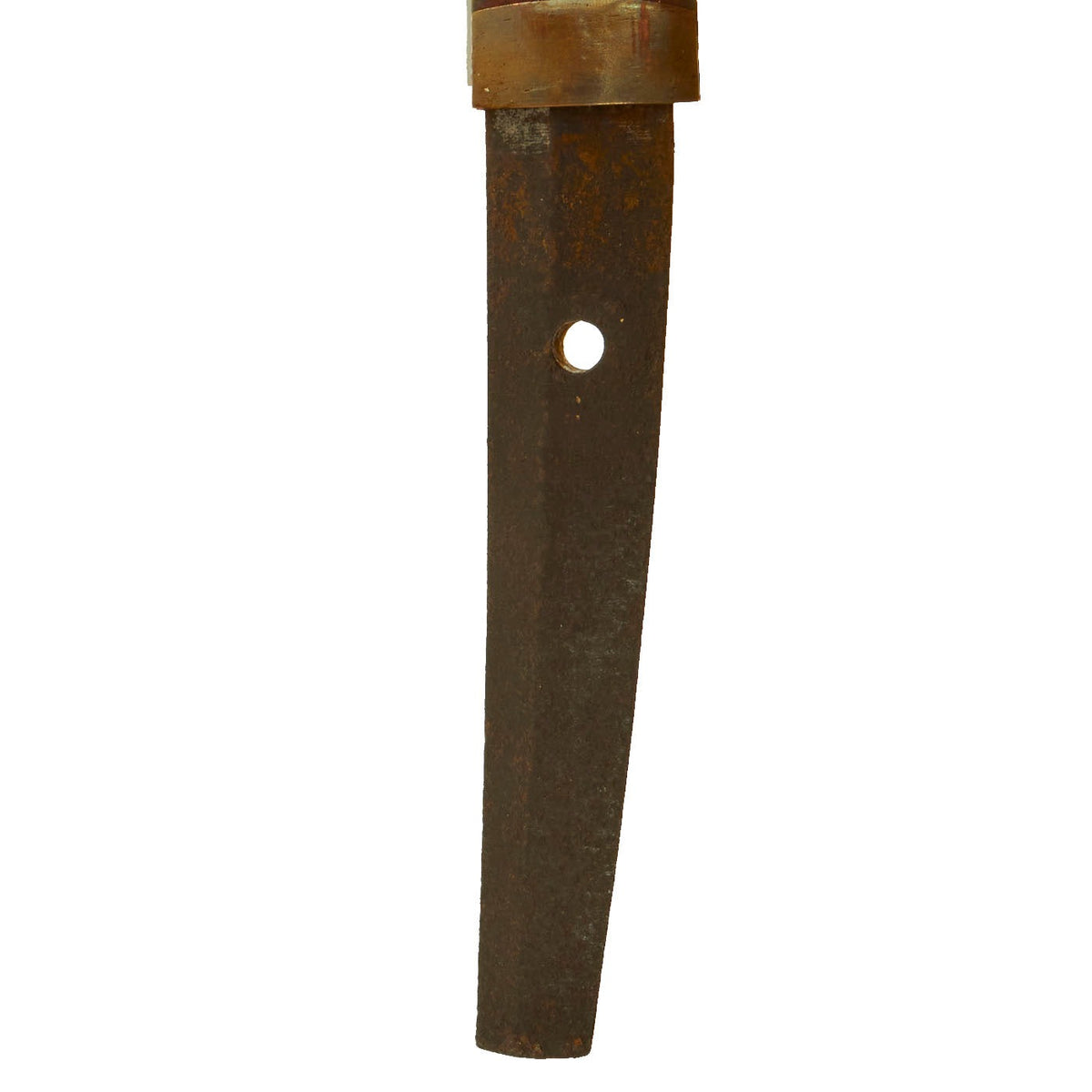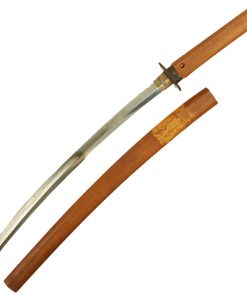Original Edo Period Japanese Wakizashi Short Sword in Resting Scabbard with Crossguard – Handmade Blade Original Items
$ 1.595,00 $ 398,75
Original Item: Only One Available. Wakizashi (脇差 “side inserted / companion sword”) is a general term for a sword with an edge between one and two shaku long (30 cm and 60 cm), predominantly made after 1600. Generally it is the short blade that accompanies a katana in the traditional samurai daisho pairing of swords, but may be worn by classes other than the samurai as a single blade, also worn edge up as the katana.
This example is estimated to be about 200 years old, dating from the Edo period (江戸時代, Edo jidai) or Tokugawa period (徳川時代, Tokugawa jidai) of Japanese history. This is the period between 1603 and 1867, when Japan was under the rule of the Tokugawa shogunate and the country’s 300 regional daimyo. It is towards the upper side of the blade length range, and has a “Shinogi Zukuri” shape, the most common shape used, and the standard for the longer Katana. This is sometimes termed an “O-Wakizashi”, or “big companion sword.”
The tang of the blade definitely shows some age, but does not look to have been refit many times. As it is unsigned, this blade is considered 無名 (mumei), or “anonymous”.
The blade has the following period correct features:
– Folded steel blade (fold lines are evident on the spine and body of the blade)
– hole in the tang is punched and not drilled
– blade has a temper line (hamon), which is easily visible.
– Blade shows grain (hada) in the body of the blade (ji)
The blade of this example is 19 7/8 inches long, and the polish on the blade is very good, showing characteristics of the blade clearly. There is some scuffing and light oxidation in places, but overall it is quite nice. The edge is still quite sharp, so care is needed, and there are just a few tiny dents/nicks on the edge. Overall length of this wakizashi is 28 3/4 inches. It the blade shape is the Shinogi-zukuri, which has a blade ridge (shinogi-ji) as well as a tip (kissaki). This is the standard shape used for longer Wakizashi and almost all Katana.
The hamon (temper line) is still fully visible, and is a very attractive CHOJI (Clover Tree Flower) with lots of activity visible inside. Nie Crystals are visible on the transition to the hamon, and there is Nioi cloudiness visible with lamination lines. The tang (nakago) is of the futsu 普通 (regular) style, with a Kuri-jiri (rounded) nakago-jiri. The body of the blade shows MASAME (straight) Hada (grain), and the boshi (tip temper line) is of the KOMARU (small turnback) type, with the yokote still crisp. The blade collar (habaki) is copper and made from two pieces, typical of Edo period blades.
This sword is mounted in a “resting scabbard” or Shirasaya, which is intended for storing the blade when it is not in use. The tsuka (handle) and saya (scabbard) are both stained from age and handling, and there is a bit of splitting along the glue line on both. There is also an old label on the scabbard, which could be a WWII surrender tag. It is illegible and mostly worn away unfortunately. The handle is held on by what looks to be a period mekugi (peg).
Interestingly, this Shirasaya was adapted to have a tsuba (crossguard) above the handle, and also has a fuchi (grip collar). It is very possible that the fittings were modified for the last ditch defense of Japan, intended to repel a ground invasion that never happened. The iron crossguard is of the rounded (Maru Gata) shape, and has two Hitsu-ana accessory slots. There are also heart Motifs inlet into the corners. The brass fuchi has a cow on it with some leaves.
A great late Edo Period wakizashi in good polish with a very nice resting scabbard and crossguard. Ready to research and display!
Specifications:
Blade Length: 19 7/8″
Blade Style: Wakizashi – Shinogi-zukuri
Overall length: 28 3/4“
Scabbard Length: 22“
It has been over one thousand years ago that the art of making swords appeared in Japan. The swordsmiths of the time may not have known it but they were creating a legendary sword. The Samurai sword has seen combat in many battlefields. From the early days of the Samurai warrior to the fierce battles in the South Pacific during WWII.
Each hand-made Japanese blade (日本刀 – Nihonto) is unique because it is forged from multiple pieces of folded steel stock. A tremendous amount of work is dedicated to creating these pieces. They were an instrument of war as much as a beautiful artifact to adorn a room.
The traditional Japanese blade and mountings have grown to be one of the most highly desired military antiques.
Fast Shipping with Professional Packaging
Thanks to our longstanding association with UPS FedEx DHL, and other major international carriers, we are able to provide a range of shipping options. Our warehouse staff is expertly trained and will wrap your products according to our exact and precise specifications. Prior to shipping, your goods will be thoroughly examined and securely secured. We ship to thousands clients each day across multiple countries. This shows how we're dedicated to be the largest retailer on the internet. Warehouses and distribution centres can be located throughout Europe as well as the USA.
Note: Orders with more than one item will be assigned a processing date depending on the item.
Before shipping before shipping, we'll conduct a thorough inspection of the items you have ordered. Today, the majority of orders will be delivered within 48 hours. The delivery time will be between 3-7 days.
Returns
The stock is dynamic and we cannot completely manage it because multiple stakeholders are involved, including our factory and warehouse. So the actual stock may alter at any time. It's possible that you may not receive your order once the order has been made.
Our policy is valid for a period of 30 days. If you don't receive the product within 30 days, we are not able to issue a refund or an exchange.
You can only return an item if it is unused and in the same state as the day you received it. You must have the item in its original packaging.
Related products
Uncategorized
Uncategorized
Uncategorized
Uncategorized
Uncategorized
Uncategorized
Uncategorized
Australian WWII Owen MK1 Machine Carbine SMG Custom Fabricated Replica with Sling Original Items
Uncategorized
Uncategorized
Uncategorized
Armored Burgonet Helmet & Polearm from Scottish Castle Leith Hall Circa 1700 Original Items
Uncategorized
Uncategorized
Uncategorized
Uncategorized
Uncategorized
Uncategorized
Uncategorized
Uncategorized
Angolan Rebel 1970s era 60mm Inert Display Mortar from Angolan Civil War Original Items
Uncategorized

